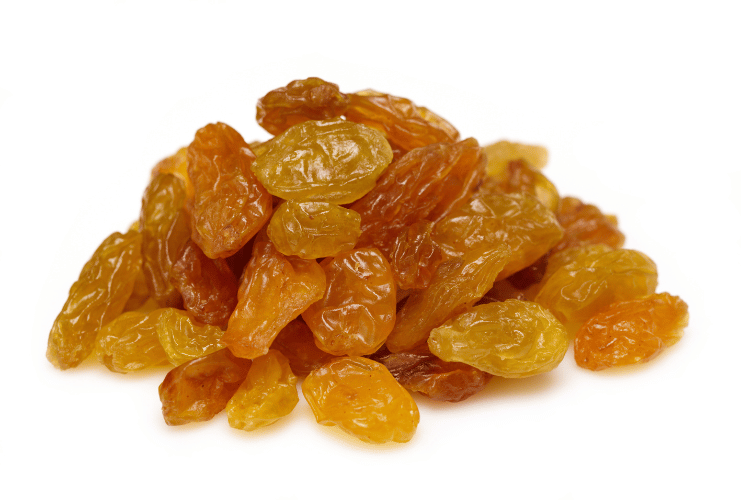
Raisins are a versatile, nutrient-packed snack that many enjoy, from toddlers to adults. Despite their small size and soft texture, raisins can pose a serious choking risk if not eaten carefully, particularly for young children, older adults, and other high-risk individuals. While their nutritional value is undeniable, it is essential to understand why raisins may be hazardous and how to enjoy them safely without worry.
This detailed guide will explore why raisins are a common choking hazard, who is most at risk, and measures you can take to minimize the risks. We’ll also provide practical preparation tips, compare raisins with other dried fruits, and share ways to safely enjoy their health benefits while avoiding potential dangers.
Why Are Raisins a Choking Hazard?
At first glance, raisins may seem harmless. They’re small, soft, and easy to eat. However, these same attributes can make raisins dangerous in specific situations. Here are the main reasons raisins are considered a choking hazard.
Key Factors Contributing to the Risk
-
Small Size and Irregular Shape Raisins are small, but their irregular shape makes them a potential choking risk, especially for toddlers or individuals with narrow airways. When swallowed without chewing, they can wedge themselves in the throat or airway.
-
Sticky Texture Once chewed, raisins become gummy and adhere to the mouth, teeth, or the roof of the throat, making swallowing difficult. Their stickiness also increases the chance of getting lodged in the airway if accidentally inhaled.
-
Clumping Tendency Raisins naturally stick together, so eating a handful without separating them can create a sticky, obstructive mass in the throat, further increasing choking potential.
-
Improper Chewing Many toddlers and young children have not yet developed the skill of thoroughly chewing their food, especially sticky or gummy foods like raisins. This increases the risk of swallowing larger, dangerous chunks.
Are Raisins More Dangerous Than Other Dried Fruits?
Compared to dried fruits like apricots, prunes, or cranberries, raisins may carry higher choking risks because of their size, density, and tendency to clump. For example, larger dried fruits are typically served sliced or in smaller portions, reducing the choking hazard, while raisins are often eaten whole.

Who Is Most at Risk?
While most adults can enjoy raisins without concern, certain groups are at higher risk of choking due to their physical or developmental limitations.
High-Risk Groups
-
Babies and Toddlers Children under the age of four are the most at risk due to their smaller airways and underdeveloped chewing and swallowing skills. Pediatric experts recommend modifying raisins for younger children or delaying the introduction until they reach specific developmental milestones.
-
Older Adults Seniors with conditions like dysphagia (difficulty swallowing) or reduced saliva production are more likely to struggle with sticky or dense foods such as raisins.
-
People with Neurological or Medical Conditions Individuals with disorders like cerebral palsy, Parkinson’s disease, or who have experienced a stroke may have impaired swallowing or muscle control, increasing the risk of choking.
-
Distracted Eaters Children and adults who eat while moving, talking, or playing are at higher risk of choking. Given their sticky nature, Raisins present an even more significant hazard.
When Can Toddlers Safely Eat Raisins?
Most experts recommend introducing raisins after 18–24 months, when children have developed stronger chewing skills and molars. Even then, they should be carefully prepared to minimize risk. Signs that a child may be ready include chewing solid foods effectively, sitting without assistance during meals, and properly handling small pieces of food.

When Can Toddlers Safely Eat Raisins
How to Minimize the Risk?
Follow these measures to reduce risks for children and high-risk individuals so they can safely enjoy raisins without worrying about choking hazards.
Preparation Tips
-
Chop or Mash Raisins For toddlers or individuals with swallowing difficulties, chop raisins into smaller pieces or mash them into softer foods like oatmeal or yogurt. This makes them easier to chew and swallow.
-
Rehydrate Raisins Rehydrating raisins by soaking them in warm water, juice, or milk for a few minutes softens their texture, reducing stickiness and clumping. This is particularly useful for younger children or seniors with swallowing challenges.
-
Mix with Moist Foods Combine raisins with soft, moist foods such as porridge, smoothies, or mashed fruit. This modifies the raisins' texture and makes them less likely to clump together.
Supervised Eating
- Constantly monitor young children during snacks and meals to ensure they eat slowly and chew thoroughly.
- Encourage seated, distraction-free eating instead of eating on the go or while talking.
Avoid for High-Risk Groups
Delay introducing raisins to babies under 12 months and younger toddlers unless they are adequately prepared. Consult with a healthcare provider before including raisins in the diet of individuals with medical conditions or swallowing issues.
Learn First Aid for Choking
Knowing how to react during a choking emergency is essential. Parents and caregivers should familiarize themselves with first aid techniques for choking, including back blows and abdominal thrusts.
Nutritional Benefits of Raisins
Raisins are convenient and packed with nutrients, making them a valuable part of a healthy diet when enjoyed safely.
Key Nutritional Components
-
Fiber Raisins are rich in dietary fiber, promoting good digestion and helping to prevent constipation.
-
Iron A key mineral for preventing anemia, especially in toddlers and women.
-
Potassium Supports muscle function and heart health by maintaining healthy blood pressure levels.
-
Natural Sugars Raisins provide quickly available energy, which is especially beneficial for active children or athletes.
-
Antioxidants Protect the body’s cells from oxidative stress, reducing the risk of chronic diseases.
Safe Ways to Incorporate Raisins into Meals
- Sprinkle chopped or rehydrated raisins over oatmeal or porridge.
- Mix into soft baked goods like muffins or bread.
- Add to smoothies for natural sweetness.
- Combine with other fruits in a soft fruit salad.
Frequently Asked Questions
Q: At what age can babies start to eat raisins?
A: It is generally recommended to wait until your child is 12 months old before introducing raisins, as they can present a choking hazard for babies and toddlers.
Q: Why are raisins considered a choking hazard for babies?
A: Raisins are chewy and sticky, which can increase the risk of choking, especially for infants and toddlers still learning to chew and swallow solid food.
Q: How can I prevent choking when giving my toddler raisins?
A: To prevent choking, cut raisins into smaller pieces and monitor your toddler while they eat. It is also advisable to give only one raisin at a time.
Q: Are there any healthy alternatives to raisins for babies under 12 months?
A: Yes, pureed fruits or soft, well-cooked vegetables are healthy snack alternatives for babies under 12 months that do not pose a choking risk.
Q: Can I give my 9-month-old baby raisins?
A: It is best to wait until your child is at least 12 months old to give raisins, as they can be a choking hazard for a baby under that age.
Q: What should I look for in a snack for my toddler?
A: When selecting a snack for your toddler, look for options that are healthy, easy to chew, and an appropriate size to avoid potential choking. Raisins can be a good snack if cut into smaller pieces.
Q: How do I know if my child is ready to eat raisins?
A: Your child should be able to chew and swallow solid food properly, typically after 12 months of age. It is important to observe their eating habits and consult with a pediatrician if you have concerns.
Q: What are the nutritional benefits of raisins for toddlers?
A: Raisins are a good source of fiber and natural sugars, making them a healthy snack option when given in moderation and in appropriate sizes to prevent choking.
Q: Should I rehydrate raisins before giving them to my toddler?
A: While it is not necessary to rehydrate raisins, doing so may make them softer and easier to chew, potentially reducing the choking risk for younger toddlers.
The Bottom Line
Raisins are nutritious and delicious, but their small, sticky nature demands caution, especially when serving young children or high-risk individuals. You can enjoy their many health benefits by preparing raisins correctly, supervising meals, and being aware of choking hazards safely.
With these practical tips and precautions, you can ensure raisins remain a healthy and enjoyable snack for the whole family.








 Login with Google
Login with Google Login with Facebook
Login with Facebook